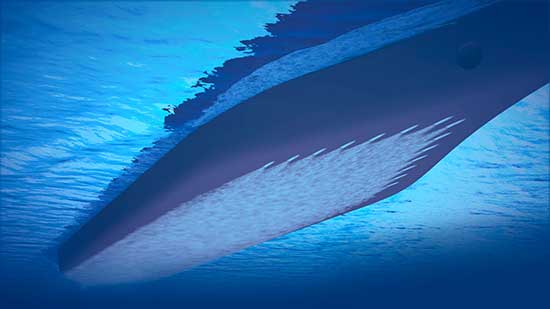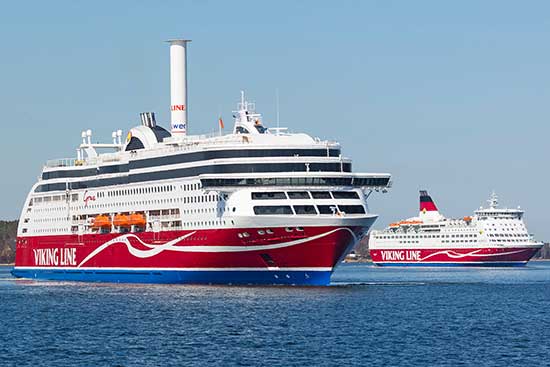靠这家公司的“黑科技”,航运业拥抱绿色未来

|
到了明年,依旧将有几百万名游客在嘉年华公司的游轮上,一边喝着香槟,一边观赏船舷边的日落。而与此同时,嘉年华公司的工程师们却会集中精神观察着船身下方的一组泡泡。 在接下来的几个月里,嘉年华公司的工程师们要把这些重达11.5万吨的邮轮拖进干船坞,然后爬到船壳底下,将9个席梦思床垫大小的金属箱焊接到船壳外边,使它们呈“V”字形排列,然后在邮轮内部安装空气压缩机。这套系统是由Silverstream Technologies公司研发的,它可以在邮轮和海水之间形成一层由气泡构成的气垫。这样做的好处是可以减少海水的阻力,将燃油效率提高5%至10%。这样下来,每艘邮轮每年便可以节省100万美元的成本。 嘉年华公司负责海运技术的副总裁迈克·卡奇马雷克表示:“一艘邮轮就好比一座海上的城市,会消耗大量能源。我们一直在寻找最新的前沿科技。而这个理念很简单,很聪明,而且很管用。” 航运业是全球的排污大户。就在这家全球最大的邮轮公司想方设法提高能源效率的同时,整个航运业从今年1月开始也迎来了全新的环保规定。面临严格的环保新规,各大航运公司也是新招迭出,有的用上了充满未来感的风帆技术,还有的用上了超大号的电池,各种“黑科技”纷纷亮相。 虽然如此,但要想切实减轻航运业对环境的影响,仍然是一个艰巨的挑战。海运是世界贸易的中流砥柱,每年还有数百万游客乘船旅行。对于这样一个巨大的产业,新技术本身能做的毕竟还是有限的。 无论是运油轮、集装箱船还是邮轮,都会消耗大量的燃料。船用燃油含有大量的硫,这意味着它燃烧时释放的有毒气体和有害颗粒比汽车燃油还多。总的来看,航运业排放的温室气体约占全球排放总量的2.5%,并且要为几百万个儿童哮喘病例和数千人的过早死亡负责。 为了降低航运业对环境的影响,联合国下属的国际海事组织要求,到2020年,所有国际轮船(除游艇外)使用的燃油的含硫量不得超过0.5%(目前的要求为含硫量不超过3.5%)。要使用这种清洁燃油,全球航运企业的燃油成本就会上涨30%到60%,约合每年300亿美元。 特拉华大学的海洋科学与政策教授詹姆斯·科比特评价道:“这是一个世纪以来,全球海运燃料领域最显著的进步。” Silverstream Technologies公司的总部位于英国伦敦。过去9年间,该公司的创始人诺亚·西伯施密特一直在努力让行业关注这家公司的空气润滑技术。该技术的物理学原理早在1865年就出现在了相关文献上,但各大航运公司直到最近才开始接受这项技术。除了嘉年华公司之外,挪威邮轮公司旗下的邮轮、荷兰皇家壳牌旗下的一艘运油船,以及意大利航运巨头Grimaldi集团旗下的十几艘货轮也用上了这项技术。西伯施密特表示:“以前,人们对这种激进的想法并不感冒,而现在整个行业都在觉醒。” 除了利用空气润滑技术,嘉年华公司还在研究利用其他技术来节能减排。比如采用能够减少污染排放的滤清器,采用更流畅的船身设计来减少阻力,采用液化天然气等清洁能源,等等。该公司正在探索的技术还有很多,这些只不过是其中的一部分。 为了实现节能减排目标,过去四年间,丹麦航运巨头马士基集团在类似的项目上已经投资了10亿美元。马士基在全球运营着700余艘货轮,该公司计划到2050年实现碳中和的目标。马士基的航运技术主管奥利·格拉·雅克布森表示:“在接下来的10年里,我们需要一些大的突破。” 其中,转子风帆技术可能是一项的重大创新,也就是下图中这个高大的、会旋转的圆柱体。它是由芬兰的初创企业Norsepower生产的,其工作原理与传统的风帆类似,但自动化程度更高,动力也更强劲。它可以减少轮船5%到20%的燃料消耗。马士基和维京邮轮公司已经在一些船舶上安装了这套设备。 |
Next year, millions of vacationers will sip Champagne as they watch the sun set over the ocean on Carnival cruise ships. All the while, company engineers will be engrossed by a different set of bubbles—under their vessels. In the coming months, Carnival’s engineers will begin pulling 115,000-ton ships into dry dock and crawling beneath the hulls. There, they’ll weld nine mattress-size metal boxes to the outside of each hull in the shape of a “V” and install air compressors inside the vessels. The system, from Silverstream Technologies, will ¬create a carpet of tiny air bubbles between the ships and the water. The expected benefit: less drag and 5% to 10% better fuel efficiency, achieving up to $1 million in annual savings per ship. “Just one ship is like a floating city consuming energy,” says Mike Kaczmarek, Carnival’s vice president of marine technology. “We’re always looking out for new, cutting-edge advances, and this concept is simple, clever, and it works.” The world’s largest cruise ship company’s quest for energy efficiency comes as the maritime industry, among the world’s biggest polluters, faces sweeping new environmental regulations in January. The new rules are forcing shipping companies to clean up their act, and they’re responding by deploying everything from futuristic sails to supersize batteries. That said, reducing the environmental impact of shipping is a profound challenge. New technologies, by themselves, can do only so much for an industry that transports a huge chunk of world trade and ferries millions of tourists. Oil tankers, container ships, and cruise liners guzzle massive amounts of fuel. This “bunker” fuel is chock-full of sulfur, which means it emits more poisonous gases and harmful particles when burned than does motor-vehicle fuel. All told, the maritime industry is responsible for 2.5% of all greenhouse gases along with millions of childhood asthma cases and thousands of premature deaths. In 2020, the United Nations’ International Maritime Organization will try to reduce that environmental impact by requiring all international vessels except yachts to use fuels that contain no more than 0.5% sulfur, down from today’s limit of 3.5%. The cleaner fuel will drive fuel costs up 30% to 60%, or an estimated $30 billion annually. “This is the most dramatic improvement in global marine fuels in a century,” says James Corbett, a marine science and policy professor at the University of Delaware who co-led the research that prompted the new rules. For nine years, Silverstream founder Noah Silberschmidt struggled to get attention with his London-based company’s air lubrication technology. The physics behind the bubble tech was first mentioned in maritime literature in 1865, but big shipping companies only recently started embracing it. In addition to Carnival’s leap into bubbles, Silverstream’s technology is being used by Norwegian Cruise Line, a Royal Dutch Shell oil tanker, and soon, a dozen Grimaldi Group cargo ships. “People weren’t interested in radical thinking,” Silberschmidt says. “Now the industry is waking up.” Besides bubbles, Carnival is investigating additional techniques to reduce fuel costs and emissions. Scrubbers that cut pollution, sleeker ship designs that reduce drag, and cleaner fuels like liquid natural gas are just some of the possibilities. Maersk, the Danish shipping giant, has put $1 billion behind a similar effort over the past four years. The company, which operates 700 container ships, intends to be carbon neutral by 2050. “In the next 10 years,” says Ole Graa Jakobsen, Maersk’s head of fleet technology, “we need some big breakthroughs.” One such innovation may be rotor sails: tall, spinning columns manufactured by Finnish startup Norsepower that work like wind sails but are automated and more powerful. They reduce fuel consumption by 5% to 20%. Maersk and Viking Line have already installed them on some ships. |

|
排放并不是航运行业唯一的污染问题。2016年,嘉年华公司因为向海洋中倾倒塑料、食物和生活废水而被判处4000万美元罚款,并被列入五年观察期名单。今年夏天,该公司又因为在观察期内再次违规,而被判罚款2000万美元。 鉴于航运业以往的“劣迹斑斑”,有环保人士担心,一些公司可能会无视这些新规。在许多情况下,监管松懈的国家都需要加强执法力度,比如利比里亚和巴拿马,而在这些国家,注册的船只数量也越来越多。 嘉年华公司的副总裁卡奇马雷克表示,不管怎样,嘉年华公司一定会致力于降低对环境的影响,而在这个过程中,空气润滑技术能够扮演一个重要的角色。“我们的邮轮必须符合环保规定。目前在邮轮领域的研发并不多,所以我们必须解决这个问题。”(财富中文网) 本文另一版本登载于《财富》杂志2019年11月刊,标题为《大型船只走向绿色未来》。 译者:朴成奎 |
Emissions are not the industry’s only pollution problem. In 2016, Carnival was hit with a $40 million fine and five years of probation for discharging plastic and food into the ocean, while also illegally dumping “gray water” from showers and kitchen sinks. This summer it received another $20 million fine for violating that probation. Given the industry’s spotty track record, environmentalists are concerned that some companies will flout the new rules. In many cases, enforcement will fall on countries with lax oversight, like Liberia and Panama, where an increasing number of vessels are registered. Whatever the case, Carnival’s Kaczmarek says his company is committed to reducing its environmental impact, and bubbles may play an important role. “Our ships have to be in compliance. There’s not a ton of R&D in cruising, so we have to figure it out.” A version of this article appears in the November 2019 issue of Fortune with the headline “Big Ships Tack to a Greener Future.” |













